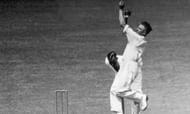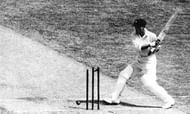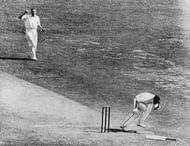The England tour of Australia for the Ashes in 1932-33 has gone down in history as the most controversial series ever played. The England team, under newly appointed captain Douglas Jardine, travelled to Australia with extensive strategies to counter the aggressive Australian batsmen, and more importantly to stop a marauding Don Bradman.
The tour has gone down in annals of history as one of the most significant events in the game and it was instrumental in changing several dynamics of the game in later years to come.
The build-up
The 1930 Australia tour of England had been a nightmare for the hosts. Australia had won the 5-match series 2-1, and while the scoreline may suggest that the series was closely contested, there was a huge gulf of class between the two teams.
Don Bradman had scored a mind boggling 974 runs in the series at 139.4 runs per innings, a record that is yet to be broken. Bradman’s average in that period was close to a hundred, and it was becoming almost impossible to stop him in full flow. The seeds of Bodyline were sown in the Oval Test in that series, when after a light rain stoppage Bradman was seen to struggle against short pitched deliveries that were skidding off the track.
When Jardine was appointed captain for the 1932 tour of Australia, he saw footage of the previous series, hoping to find something to aid his bowlers on the tour. After watching Bradman’s struggle, he realised he had found the perfect weapon to stop Bradman and Australia.
Harold Larwood and Bill Voce, England’s premier fast bowlers, had been selected for the tour. Jardine met up with them and discussed in detail about the strategies he planned to employ on the tour and instructed the duo to practice bowling short pitched deliveries on the leg stump.
Although Larwood and Voce accepted the ploy, the third frontline bowler, Gubby Allen was sternly against negative tactics and refused to bowl to a bodyline fielding, opting instead to bowl conventionally.
Bodyline
The strategy of Bodyline, or fast leg theory bowling, is quite simple. The rules at that time were not as strict as they are today; the fielding positions were generously flexible. The main idea was to constrict a batsman for any room to play an attacking shot, with the line of bowling being primarily on the leg stump and pitching it short.
There would be several fielders behind the batsman, something akin to a conventional slip cordon but on the batsman’s on side, and a short pitched delivery on the body would be fended off awkwardly by the batsman on the leg side, which brought the leg side field into play.
Jardine did not employ this tactic in the practice matches leading up to the first Test, wanting to save his trump card for the real thing. The first Test was played at the Sydney Cricket ground. Australia played under the captaincy of Bill Woodfull, and fielded a strong team despite missing Bradman due to injury.
Harold Larwood, described by many commentators as the finest bowler of his generation, was known for his extreme pace and deadly accuracy. Although there were no speed guns during the time, tests carried out in later years from video footages have shown that he could regularly touch speeds in excess of 95 mph.
The number is terrifying even today, and what made it all the more intimidating was the batsmen in those days used to play without a chest guard and a helmet.
Larwood was near unplayable on the first day, with all the batsmen surrendering to the Bodyline tactics. The only one who stood tall among the ruins was Stan McCabe, who despite taking several blows on the body, hooked and pulled bravely and fought his way to 187.
Australia lost the match by 10 wickets, with Larwood getting a 10 wicket haul in the match. Bradman returned for the second Test in Melbourne, and was dismissed for a golden ball duck in the first innings, leaving the whole stadium in shock and the England players in jubilation.
Jardine is famously remembered to have danced wildly following Bradman’s wicket. Bradman however made a strong reply in the second innings, and his match winning century levelled the series 1-1.
The third Test at Adelaide has been described by Wisden as “the most unpleasant Test in the history of the game”. The second day of the Test saw England’s first innings fold at 341 and Bill Woodfull and Jack Fingleton opened the batting for Australia. Larwood was initially bowling to a traditional field setting to Woodfull.
However, in his second over, he struck Woodfull on the chest over the heart. Woodfull was unable to resume for several minutes and was in agonizing pain. To the surprise of everyone, Jardine set up a bodyline field in Larwood’s next over with Woodfull at the crease.
A strong crowd of 50000-odd Australians was jeering and hooting the English team at this bizarre play. Woodfull bravely stood up to Larwood and co. for 89 painful minutes of body blows and bruises, when he was bowled by Allen for 22. Bill Ponsford also had bruises all over his back and shoulders, as a result of his attempts to shield his bat from short pitched deliveries.
Australian keeper Bert Oldfield got the worst of it, when he mishit a pull and the ball crashed on his head, fracturing his skull. Ironically, it was non-bodyline ball, and Oldfield admitted his own mistake at mistiming the ball. Set a near impossible target of 532, Australia could only manage 193 as England took a 2-1 lead in the series.
The Outrage
The antics of the third Test caused the Australian Cricket board to send a cable to the MCC in London in which they branded England’s conduct as being unsportsmanlike. The cable caused uproar in both the countries with Jardine threatening to withdraw from the last two Tests if the allegations were not dropped.
In order to save the strong economic ties of the two countries, after an intervention from the Australian prime minister, the Australian Cricket Board withdrew their allegations and the two Tests were conducted as scheduled. Australia, wounded physically and psychologically, lost both the matches and the series 1-4.
Douglas Jardine strongly defended his tactics, stating that his only motive was to take wickets and not injure players. Larwood and Voce maintained that they had only bowled the leg theory bowling line under orders from their captain.
Bill Woodfull received nationwide praise for his sporting conduct and leadership during the season and his refusal to adopt the same tactics against England was applauded by the Australian media.
The fallout
Bradman, for whom the tactic had been originally devised, had an average of 56.57 in the series which is excellent by any standards, though well short by his own supremely high standards.
The series had a drastic impact on the game. Bodyline came to be regularly used in English County cricket and even in other international matches and was strongly condemned. The MCC introduced new laws in the game at the start of the 1935 English season.
Restrictions were imposed on the number of fielders allowed on the leg side behind the batting crease and a maximum of two fielders are now allowed behind the crease at the time of delivery. The maximum number of bouncers above shoulder height allowed in an over is now restricted to two.
The MCC was strongly reprimanded for not taking any action following the series. Larwood was asked to issue a written apology for his bowling in Australia by the MCC. An outraged Larwood refused to do so, stating that he had only done what his captain had ordered him to do. Harold Larwood never played for England again.
Follow IPL Auction 2025 Live Updates, News & Biddings at Sportskeeda. Get the fastest updates on Mega-Auction and cricket news




